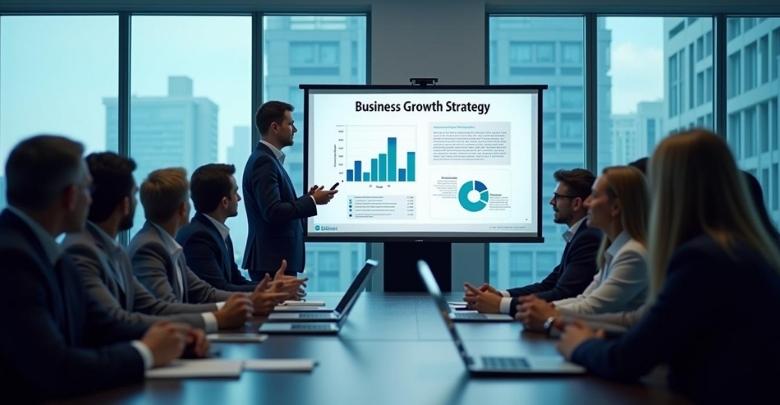Have you ever attended a Canadian conference? It’s a prime opportunity to immerse yourself into the heart of your industry, surrounded by fellow professionals and potential clients. If you’re gearing up for such an event, you might find yourself pondering: How do I promote my business at a conference in Canada?
To effectively promote your business, choose a conference that aligns with your industry and target audience. Craft a compelling booth design and prepare engaging materials that highlight the individuality of your business. Utilize digital tools for promotion before and during the conference to maximize your visibility and attract more visitors to your booth.
Are you curious about maximizing your conference experience? This article will guide you through innovative strategies to promote your business effectively at Canadian conferences. Read on to discover essential tips that will ensure your business stands out and makes a significant impact.
Why Are Conferences in Canada Ideal for Business Promotion?
Conferences in Canada offer a great platform for business promotion due to the country’s diverse economic environment and accessibility to global markets. The convergence of varied industries, including technology, healthcare, and energy, creates an ideal backdrop for businesses looking to expand their reach and influence. The multicultural and bilingual landscape also helps engagement, allowing businesses to target their messaging to a broad audience.
Moreover, Canada’s strong commitment to innovation and development is reflected in its conferences, which frequently feature innovative topics and high-caliber attendees. This environment not only facilitates learning and development but also provides businesses with the opportunity to showcase their latest products and services to an engaged and relevant audience.
The conference industry in Canada generates substantial economic activity each year, attracting thousands of delegates from across the globe. This makes the conference in Canada an excellent opportunity for businesses to gain exposure, connect with new clients, and build partnerships within a robust and supportive framework.
How Do I Promote My Business at a Conference in Canada?
In Canada, promoting your business at conferences offers a great opportunity to reach out directly to your target audience, expand your network, and improve your brand’s visibility. Canadian conferences draw a diverse mix of industries and professionals, providing fertile ground for promoting your business effectively. Here’s an extensive guide on how to make the most of these opportunities.
Choose the Right Conference
Effective business promotion requires careful conference selection. Research conferences that align closely with your industry and business goals. Look for events where attendees are likely to be interested in your products or services. Consider the size, scope, and reputation of the conference to ensure it matches your target demographic. Attending the right conference can maximize your exposure to key players and potential clients in your field.
Plan Your Strategy in Advance
Preparation is key to success. Start by setting clear objectives for what you want to achieve, such as generating leads, enhancing brand awareness, or establishing partnerships. Develop a strategy that includes pre-conference promotions, activities during the conference, and follow-up actions. Engage with the conference organizers to learn about additional opportunities for exposure, such as sponsorship, speaking engagements, or participating in panel discussions.
Design an Engaging Booth
Your booth is your business’s physical representation at the conference. Make it inviting and reflective of your brand’s image. Invest in high-quality banners, informational brochures, and product samples. Ensure your booth staff is knowledgeable and ready to engage with conference attendees. Interactive elements like games, demonstrations, or tech-driven activities can attract more visitors and make your presence memorable.
Utilize Digital Tools
Incorporate digital tools to amplify your conference presence. Use social media to announce your participation and update followers in real time about conference happenings. Create a conference-specific landing page on your website or a mobile app custom-made for event networking. Consider using QR codes at your booth that link to online promotional materials or contact forms to streamline data collection.
Offer Valuable Content
Content is king in capturing the attention of conference attendees. Offer valuable content that addresses common industry challenges or highlights case studies showcasing your business’s solutions. Free resources such as white papers, e-books, or insightful studies can be powerful lead magnets. Organize workshops or seminars if the conference format allows, providing practical advice that positions your company as an industry leader.
Network Effectively
Networking is at the heart of conference success. Prepare an elevator pitch summarizing your business’s value proposition. Actively engage with other attendees during breaks, meals, and social events. Exchange business cards and make notes to remember follow-up details. Effective networking can turn casual conversations into long-term business relationships.
Follow-Up Post-Conference
The work doesn’t end when the conference does. Follow up promptly with contacts made during the event. Send personalized emails thanking individuals for their time and mentioning specific details from your conversation to jog their memory. Continue the dialogue by offering additional information or setting up meetings to discuss potential collaborations further.
Measure Your Success
Analyze the effectiveness of your conference participation. Measure success based on the objectives you set, such as the number of leads generated, the quality of new contacts, or the reach of your brand during the conference. This assessment will help refine your approach for future events and determine the return on investment of your conference activities.
How to Choose the Right Canadian Conference for Your Business?
A good Canadian conference can be an effective way to network, learn industry trends, and showcase your business. With numerous options available across various sectors, making an informed decision is essential for maximizing your investment. Here’s how to identify the ideal Canadian conference that aligns with your business goals and needs.
Assess Your Business Objectives
Before selecting a conference, clearly define what your business aims to achieve by participating. Are you looking to gain visibility, network with peers, find potential clients, or perhaps seek partnership opportunities? Your goals will guide your decision-making process, helping you focus on events that offer the best opportunities for your specific needs. Choose a conference that not only aligns with your industry but also supports the specific objectives you want to accomplish.
Research Conference Relevance
Consider the relevance of the conference to your industry and area of expertise. Look for conferences that are well-known within your sector and have a track record of attracting key stakeholders, thought leaders, and influencers. Review past conference agendas, speaker lists, and exhibitor profiles to assess the quality and relevance of the content provided. A conference that consistently features industry-relevant topics and high-caliber participants is likely to offer more value to your business.
Consider the Location and Size
The location and size of the conference are crucial factors to consider. Major cities like Toronto, Vancouver, and Montreal host larger conferences that attract international audiences and offer greater networking opportunities. However, smaller conferences in less metropolitan areas might provide more niche networking environments and greater chances for in-depth interactions. Decide based on whether your business benefits more from broad exposure or targeted, industry-specific gatherings.
Analyze Networking Opportunities
A significant benefit of attending conferences is the opportunity to network. Examine the conference format and schedule to ensure there are ample opportunities for networking. Look for events that include workshops, roundtables, social gatherings, and other interactive sessions where you can connect with other professionals. Conferences that facilitate attendee engagement through apps or social platforms can also increase networking potential.
Review the Cost vs. Benefit
Consider the financial investment required to attend the conference, including registration fees, travel expenses, accommodation, and any additional costs like workshops or special sessions. Compare these costs against the potential benefits your business could gain, such as lead generation, partnerships, and brand exposure. High costs do not always guarantee high returns, so evaluate whether the expense aligns with the expected value.
Check for Growth Opportunities
In addition to networking opportunities, conferences can provide you with opportunities to learn about new technologies, business strategies, and market trends. Conferences that include educational components like seminars, keynote speeches, and certification courses can provide significant value. These opportunities for professional development can help keep your business competitive and informed about industry advancements.
Identifying Your Target Audience at Canadian Conferences
The key to maximizing the effectiveness of your participation at Canadian conferences is to understand and identify your target audience. Whether you are looking to network, gather leads, or present new products, knowing who attends these events can significantly upgrade your strategic approach. Here’s how to accurately pinpoint your target audience at such gatherings.
Analyze Past Event Demographics
The first step is to examine past events’ demographics. Conference organizers often provide data about the industries, professional levels, and demographic details of previous attendees. This information can give you insights into who is likely to attend future conferences. In that case, knowing the typical attendance size of conferences in Canada, along with their demographic distribution, can help you adjust your marketing materials and presentations to meet the specific interests and needs of these attendees.
Assess the Conference Focus and Themes
Each conference has a unique focus and theme that attracts different types of professionals. Review the conference agenda, keynote topics, and workshop themes to understand the interests and professional backgrounds of potential attendees. For example, a conference focusing on technology for the healthcare sector will likely attract IT professionals and healthcare administrators. Aligning your business offerings with the conference themes can attract the most relevant audience to your booth or presentations.
Review Participant Lists and Exhibitors
If available, review the list of participants and exhibitors. This can provide valuable clues about the caliber and focus of the business leaders attending the conference. Exhibitor lists reveal what types of products or services are in demand, while participant lists can help you identify key influencers and decision-makers in your industry. This information is crucial for upgrading your networking strategies and promotional efforts.
Use Social Media and Online Forums
Social media platforms and online forums related to the conference can offer insights into who is attending and what topics they are interested in. Many conferences have dedicated hashtags or groups where attendees discuss sessions, coordinate meetups, or share insights. Engaging in these conversations can help you better know your audience’s expectations and interests, enabling you to customize your approach for maximum impact.
Consider Geographic and Cultural Factors
The types of professionals attracted to a conference in Canada may also be affected by geographic and cultural factors. Cities like Toronto, Vancouver, and Montreal are multicultural and attract international businesses, while other areas might be more regionally focused. Cultural factors can also influence business practices and communication styles, so customize your approach to respect and engage with these differences effectively.
How to Make Use of Local Culture in Your Promotional Activities?
Integrating local culture into your promotional activities at conferences can significantly increase your brand’s appeal and connect more deeply with attendees. This strategy not only demonstrates respect and appreciation for the host city but also enriches the overall experience for participants. Here’s how to effectively incorporate local culture into your conference promotions, especially when participating in events held in the major conference cities in Canada.
Get to know the Local Culture and Demographics
Start by researching the cultural background and demographics of the city where the conference is held. Each of the major conference cities in Canada, such as Toronto, Vancouver, and Montreal, has its unique cultural identity and local customs. Knowing about these aspects can help you modify your promotional materials and activities to resonate with both local and visiting attendees. For example, using local languages like French in Montreal or highlighting Indigenous art and symbols in Vancouver can create a more inclusive and engaging promotional campaign.
Incorporate Local Themes and Symbols
Incorporate themes and symbols that are iconic to the city into your conference booth design, giveaways, and promotional materials. This could include local landmarks, historical figures, or famous cultural symbols. For instance, incorporating imagery of the CN Tower or maple leaves when in Toronto, or using the ocean and mountain motifs in Vancouver, can improve the visual appeal of your promotional materials and create a sense of place that connects attendees to the location.
Partner with Local Businesses and Artisans
Collaborate with local businesses and artisans to provide distinctive local experiences or products at your booth. This could involve featuring local crafts, foods, or entertainment that reflect the city’s cultural heritage. Partnering with local vendors not only supports the local economy but also provides conference attendees with an authentic experience of the city’s culture. Such partnerships can generate positive buzz around your booth and help your brand stand out.
Engage with Local Stories and Content
Create promotional content that tells stories or shares facts about the local area. This could be historical anecdotes, stories of local heroes, or interesting facts about the city’s development and culture. Incorporating these elements into your presentations, videos, or social media can engage attendees and give them a richer perspective of the host city. Engaging content that celebrates the local culture can leave a lasting impression and stimulate greater attendees’ interest in your booth.
Utilize Local Media Channels
To maximize your reach, utilize local media channels to promote your presence at the conference. This can include local radio stations, newspapers, and online platforms. Advertising in local media or arranging interviews to talk about your participation can increase visibility among local attendees and drive more traffic to your conference activities. Ensuring your promotional messages are culturally aligned and locally relevant can significantly boost their effectiveness.
Legal Considerations When Promoting Your Business at a Conference
It takes more than just good marketing techniques to promote your company at a conference; you also need to follow a number of legal requirements. Ensuring that your promotional activities adhere to local laws and industry regulations is crucial to avoid potential legal pitfalls. Here’s a guide to assessing the legal environment when showcasing your business at a conference.
Understand Advertising and Promotion Laws
Before engaging in any promotional activities, familiarize yourself with the local advertising laws. This includes regulations concerning truth in advertising, which mandate that your marketing materials must not mislead attendees. Ensure that all claims about your products or services are substantiated and that any comparisons with competitors are fair and verifiable. Compliance with these laws will prevent legal issues and uphold your business’s reputation.
Respect Intellectual Property Rights
Intellectual property (IP) rights are a crucial consideration when creating promotional materials. This includes respecting trademarks, copyrights, and patents. For instance, if you plan to use multimedia presentations, images, or music at your booth, ensure you have the necessary permissions or licenses. Violating IP rights can lead to lawsuits and significant financial penalties, so you want to make sure you conduct thorough due diligence.
Comply with Venue and Event Organizer Contracts
When you register to participate in a conference, you will likely enter into a contract with the event organizers or the venue. This contract may include specific clauses regarding the type of promotions allowed, booth design standards, and the use of technology such as drones or high-volume audio equipment. Adhering to these contractual terms is essential to avoid breaches that could result in fines or being barred from future events.
Consider Privacy and Data Protection
If your promotional activities at a conference involve collecting personal data from attendees, such as names, email addresses, or business cards, you must comply with applicable privacy and data protection laws. In Canada, this includes following the Personal Information Protection and Electronic Documents Act (PIPEDA), which sets the standard for how private sector organizations collect, use, and disclose personal information.
Tips for Delivering a Memorable Business Presentation
Delivering a memorable business presentation can significantly impact your audience, whether you’re pitching to potential investors, clients, or peers. The key to success lies in your ability to engage, inform, and inspire your audience effectively. Here are some strategies to help you leave a lasting impression and stand out in any professional setting.
Get to Know Your Audience
Before crafting your presentation, take the time to know who your audience is and what they care about. Adjusting your content to meet the interests and needs of your listeners can significantly increase engagement. Use language and examples that resonate with them and anticipate the questions they might have. A well-targeted presentation ensures that your message is relevant and impactful, making it more memorable.
Start Strong
The opening of your presentation is crucial; it sets the tone and grabs your audience’s attention. Begin with a compelling story, a surprising statistic, or a provocative question that relates to your topic. This initial engagement is vital for capturing interest and establishing a rapport with your audience. A strong start not only hooks your listeners but also builds momentum for the rest of your presentation.
Utilize Visuals Effectively
Visual aids, when used correctly, can enrich your presentation and help convey your message more clearly. Opt for clean, attractive, and professional-looking slides that support and complement your speech. Avoid overcrowding your visuals with text—use them to highlight key points or to show graphs, images, or videos that illustrate your points more vividly.
Practice Delivery and Timing
The way you deliver your presentation is just as important as the content itself. Practice your delivery multiple times to ensure you are confident and fluent. Pay attention to your timing, making sure to allocate enough time to each part of your presentation without rushing or dragging. Use pauses effectively to allow your audience to absorb information, and vary your tone and pace.
Engage with Your Audience
Interaction can make your presentation more engaging and memorable. Encourage questions, provide interactive elements like polls or quizzes, or involve the audience in a short activity. These interactions can help maintain interest and give you instant feedback on your audience’s engagement and comprehension.
Conclude with a Strong Call to Action
Ending your presentation with a clear and compelling call to action (CTA) is crucial for ensuring that your message has a practical impact. Your CTA should be specific, actionable, and relevant to the content you’ve presented. Whether you’re encouraging your audience to adopt a new business strategy, contact you for further details, or simply reflect on a key point, your conclusion should reinforce the primary message of your presentation and motivate the audience to act.
Frequently Asked Questions (FAQs)
Being familiar with the nuances of conference promotion in Canada can set the stage for enhanced business growth. Below, find answers to some commonly asked questions that can help you utilize your presence effectively at these events.
What Should I Include in My Pre-Conference Marketing Materials?
In your pre-conference marketing materials, include information about what your business offers, details about the booth (like its location), and any special events or promotions you’ll be hosting. Highlight any speakers from your company, and give teasers that entice attendees to visit your booth or presentation.
How Can I Utilize Social Media During the Conference?
Use social media to engage attendees by posting live updates, behind-the-scenes content, and key takeaways from sessions. Consider using the conference’s hashtag to increase visibility. Live streaming, tweeting questions, or sharing photos can also help maintain engagement with your audience both at the conference and online.
Are There Specific Strategies for Following Up with Contacts Made at the Conference?
After the conference, send personalized follow-up emails thanking new contacts for their time. Include specific details from your conversation to jog their memory. Offer additional value through related articles, blog posts, or an invitation to an upcoming event, which can keep the conversation going.
How Can I Measure the Success of My Promotion at the Conference?
Measure your promotional success by tracking metrics such as the number of leads generated, the quality and relevance of these leads, feedback received, and the overall engagement at your booth or sessions. Post-event surveys and monitoring social media engagement can also provide insights into your promotional effectiveness.
What Are the Benefits of Partnering with Other Businesses at the Conference?
Partnering with other businesses at the conference can broaden your reach and combine resources for mutual benefit. This could include co-hosting a booth, sponsoring a session together, or conducting joint promotions. Such collaborations can increase your visibility and provide access to a wider audience, maximizing your promotional efforts.
Final Thought
Conferences in Canada provide a strategic platform for enhancing your business presence. By utilizing this opportunity effectively, you can establish lasting connections, expand your network, and significantly boost your brand visibility among industry peers and potential clients.
If you’re still thinking about how do I promote my business at a conference in Canada?, remember the essentials: identify the right event, engage effectively with your audience through well-planned booths and compelling presentations, and follow up diligently. These steps are your blueprint for making an impactful presence.
As you prepare for your next conference, focus on creating meaningful interactions and providing valuable insights to your audience. Equip your team with clear objectives and the tools to execute them flawlessly. Best wishes as you take this exciting step towards growing your business—may your efforts lead to fruitful collaborations and a strengthened market position.









